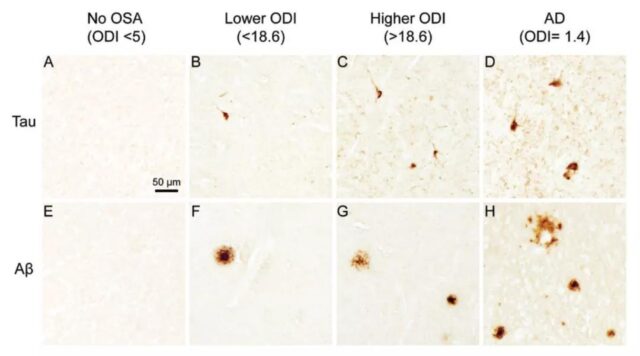People with snoring have the same brain damage as Alzheimer’s disease
- Normal Liver Cells Found to Promote Cancer Metastasis to the Liver
- Nearly 80% Complete Remission: Breakthrough in ADC Anti-Tumor Treatment
- Vaccination Against Common Diseases May Prevent Dementia!
- New Alzheimer’s Disease (AD) Diagnosis and Staging Criteria
- Breakthrough in Alzheimer’s Disease: New Nasal Spray Halts Cognitive Decline by Targeting Toxic Protein
- Can the Tap Water at the Paris Olympics be Drunk Directly?
People with snoring have the same brain damage as Alzheimer’s disease
- Should China be held legally responsible for the US’s $18 trillion COVID losses?
- CT Radiation Exposure Linked to Blood Cancer in Children and Adolescents
- FDA has mandated a top-level black box warning for all marketed CAR-T therapies
- Can people with high blood pressure eat peanuts?
- What is the difference between dopamine and dobutamine?
- How long can the patient live after heart stent surgery?
People with snoring have the same brain damage as Alzheimer’s disease, or a sign of Alzheimer’s disease.
Snoring is a relatively common phenomenon in life, and we or our relatives may also have such troubles. But everyone didn’t think it was a disease, but just thought it was a bad sleep habit.
But in fact, snoring is caused by some abnormalities of the body. It is a disease that should not be ignored. The clinical professional name is obstructive sleep apnea syndrome (OSAS). OSAS is the apnea and hypoventilation caused by the blockage or narrowing of the upper airway during sleep, which causes symptoms such as night snoring, apnea, abnormal sleep structure, etc., which causes repeated occurrence of hypoxia, daytime sleepiness, lack of concentration, etc. Phenomenon.
According to statistics, nearly 1 billion people worldwide have obstructive sleep apnea, and up to 30% of the elderly are deeply troubled. Another high-incidence disease among the elderly is Alzheimer’s disease. At present, about 50 million people worldwide suffer from Alzheimer’s disease. As society progresses and the average life expectancy of human beings increases, the prevalence of Alzheimer’s disease will continue to rise. It is estimated that there will be 150 million Alzheimer’s patients in 2050.
Scientists have long suspected an association between sleep apnea and Alzheimer’s disease, but the reason for this association is unclear. Although the specific causes of Alzheimer’s disease are still divergent, the amyloid deposits that are toxic to brain cells have been determined to be an indicator of Alzheimer’s disease.
Researchers from the Royal Melbourne Institute of Technology in Australia published a clinical research paper in Sleep magazine entitled: Alzheimer’s disease neuropathology in the hippocampus and brainstem of people with obstructive sleep apnea.
This new study shows that, like patients with Alzheimer’s disease, patients with obstructive sleep apnea also have amyloid deposits in the brains, and these precipitated plaques appear in the same brains as patients with Alzheimer’s disease. Location, and spread in the same way.
This is also the first clinically validated study to find amyloid deposits plaques similar to Alzheimer’s in the brains of patients with obstructive sleep apnea. This is an understanding of the relationship between these two diseases. The important advances in this field have also opened up new directions for the development of therapies for the treatment and prevention of Alzheimer’s disease.

Now, scientists already know that Alzheimer’s and obstructive sleep apnea are related. If a person has sleep apnea in middle age (the most intuitive manifestation is sleep snoring), then he is older It is more likely to suffer from Alzheimer’s disease at times; if a person has Alzheimer’s disease, he is often more prone to sleep apnea than his peers.
However, the reasons for the association between these two diseases are still unclear, and it is still a huge challenge to figure out the reasons and biological mechanisms of the association between the two.
In this new study, the research team examined the hippocampus of 34 patients with obstructive sleep apnea (18 females, 16 males, with an average age of 67 years) after death, and the brain stems of 24 patients with obstructive sleep apnea. organization. The test also looks for amyloid deposits and neurofibrillary tangles, which are known indicators of Alzheimer’s disease.
The test results show that in Alzheimer’s disease, amyloid deposits and neurofibrillary tangles first appear in nearby cortical areas, then transfer to the hippocampus, and then spread to the rest of the cortex.
In addition, the study found that people with obstructive sleep apnea have the same amyloid deposit plaques and neurofibrillary tangles in the brain, and the severity of sleep apnea is related to the accumulation of amyloid deposit plaques.

For those patients with mild sleep apnea, amyloid deposit plaques and neurofibrillary tangles can only be found in the cortical area near the hippocampus. This is also the first time these plaques and tangles appear in Alzheimer’s disease. The place.
In general, this is the first clinically validated study to find amyloid deposits plaques similar to Alzheimer’s in the brains of patients with obstructive sleep apnea, which is effective for these two diseases. Important advances in the understanding of the relationship have also opened up new directions for the development of therapies for the treatment and prevention of Alzheimer’s disease.
The research team said that the next stage will continue to analyze these samples to fully understand neuropathology, including signs of inflammation and changes in blood vessels that provide nutrients to the brain. At the same time, the research team also pointed out that the sample size of this study is limited, so the team will continue to work hard to establish a larger cohort of clinical studies.
Paper link:
https: //doi.org/10.1093/sleep/zsaa195
(source:internet, reference only)
Disclaimer of medicaltrend.org
Important Note: The information provided is for informational purposes only and should not be considered as medical advice.



